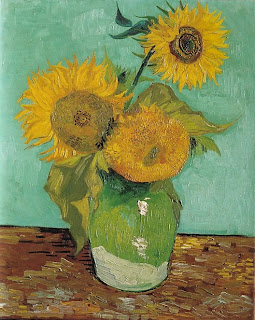Of Van Gogh and Rembrandt
I am not much into art appreciation and don’t even know the difference between a Van Gogh or a Rembrandt. But a recent visit to Amsterdam has opened my eyes to the beauty of such paintings, how they evolved, their stories, and what made them so remarkable. Below are my favorite picks:
1) Van Gogh
Do you know there are 7 versions of the Sunflowers? I always thought there was only one…
This is the first one, painted in 1888 by Van Gogh when he was 35. It's known as "Three Sunflowers in a Vase". The background is turquoise. Currently owned by a private collector in the USA.
The fifth version, painted in 1889. "Vase with 12 Sunflowers". Currently located in Philadelphia, USA. Notice the different coloured background.
This is the last one - "Vase with 15 Sunflowers", painted in 1889. Background yellow. Currently on display at the Museum of Art in Sompo, Japan.
Van Gogh first painted the sunflowers to decorate his friend, Paul Gaugain's, bedroom. Since then, he painted 7 versions of the sunflowers, one of which was sold for USD81 million at an auction in 1987.
Another one of my favourite pick for Van Gogh is the "Starry Night Over the Rhone". Splendid....
The Night Watch (1642) - a masterpiece. This is considered one of the most famous paintings in the world.
Will write more!
1) Van Gogh
Do you know there are 7 versions of the Sunflowers? I always thought there was only one…
The fifth version, painted in 1889. "Vase with 12 Sunflowers". Currently located in Philadelphia, USA. Notice the different coloured background.
This is the last one - "Vase with 15 Sunflowers", painted in 1889. Background yellow. Currently on display at the Museum of Art in Sompo, Japan.
Van Gogh first painted the sunflowers to decorate his friend, Paul Gaugain's, bedroom. Since then, he painted 7 versions of the sunflowers, one of which was sold for USD81 million at an auction in 1987.
Another one of my favourite pick for Van Gogh is the "Starry Night Over the Rhone". Splendid....
Starry Night Over the Rhone (1888)
The actual landscape for Starry Night Over the Rhone
2) Johannes Vermeer
Vermeer was another famous Dutch painter. I saw his paintings at the Rijksmuseum and straight away fell in love with it. There’s just something about her facial expression and the way she pours out the milk that captivated my attention.
The Kitchen Maid (1660) - Vermeer
Description: A maid concentrates keenly as she pours milk from a jug. It is a quiet, tranquil scene. The only movement is the flow of milk. Vermeer turned a simple composition of a prosaic subject into an intense work of art. It is in the rendering of light that Vermeer truly excelled, painting tiny dots for highlights as on the bread and the blue cloth. (Rijksmuseum)
Girl with a Pearl Earring (1665) - Vermeer
3) Rembrandt
The Night Watch (1642) - a masterpiece. This is considered one of the most famous paintings in the world.
The Night Watch is renowned for three elements: its colossal size (363 x 437 cm ~ 11 ft 10in x 14 ft 4in), the effective use of light and shadow, and the perception of motion in what would have been, traditionally, a static military portrait
This painting was completed in 1642, at the peak of the Dutch Golden Age. It depicts the eponymous company moving out, led by Captain Frans Banning Cocq (dressed in black, with a red sash) and his lieutenant, Willem van Ruytenburch (dressed in yellow, with a white sash).
With effective use of sunlight and shade, Rembrandt leads the eye to the three most important characters among the crowd, the two gentlemen in the centre (from whom the painting gets its original title, and the small girl in the centre left background. Behind them the company's colours are carried by the ensign, Jan Visscher Cornelissen.
With effective use of sunlight and shade, Rembrandt leads the eye to the three most important characters among the crowd, the two gentlemen in the centre (from whom the painting gets its original title, and the small girl in the centre left background. Behind them the company's colours are carried by the ensign, Jan Visscher Cornelissen.
In 1715, upon its removal from the Kloveniersdoelen to the Amsterdam Town Hall, the painting was cut down on all four sides. This was done, presumably, to fit the painting between two columns, an all too common practice before the 19th century (see below).
This resulted in the loss of two characters on the left-hand side of the painting, the top of the arch, the balustrade, and the edge of the step. This balustrade and step were key visual tools used by Rembrandt to give the painting a forward motion.
The picture below shows how it originally looks like. (Source: Wikipedia)
This resulted in the loss of two characters on the left-hand side of the painting, the top of the arch, the balustrade, and the edge of the step. This balustrade and step were key visual tools used by Rembrandt to give the painting a forward motion.
The picture below shows how it originally looks like. (Source: Wikipedia)
The un-cut version
I saw the Night Watch at the Rijksmuseum in Amsterdam. It was awesome. The painting was huge, it occupied the whole wall of the building. It just made me wonder how on earth did Rembrandt paint that, given its enormous size.
And that was in 1642, the year the Dutch conquered Malacca from the Portuguese. Such amazing talent...
Will write more!









Comments